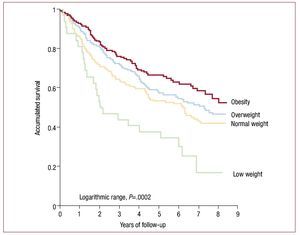To the Editor,
Obesity is considered a major risk factor for cardiovascular disease and heart failure.1,2 However, several studies suggest that, in the medium-term, there is a paradoxical relationship between obesity and heart failure prognosis, 3,4 whereby the prognosis for overweight or obese heart failure patients is better than that for normal weight patients. As previously published,4 we observed a linear relationship between body mass index (BMI) and prognosis at 2 years in patients with heart failure. Mean follow-up in studies published to date is 2.7 years,3 though one might speculate that the longer-term prognosis in obese patients would be similar to or perhaps even worse than that for normal weight patients. To test this hypothesis, we analyzed the relationship between BMI and mortality over a minimum follow-up period of 5 (5 to 8.4) years from the first visit in a population of 504 heart failure patients. The study population included patients with different etiologies treated in a multidisciplinary heart failure unit. Mean age was 68 years [interquartile range, 58-74] and 73% were male. The main etiology for heart failure was ischemic heart disease (59%) and ejection fraction (EF) of 30% [23%-39.7%]. Most patients were in functional class II (51%) or III (42%) of the New York Heart Association (NYHA). Patients were stratified into four groups based on BMI (World Health Organization classification, 1999): underweight (BMI <20.5), normal weight (BMI 20.5-<25.5), overweight (BMI 25.5-<30), and obese (BMI ≥30). The median length of follow-up was 68.4 [26.5 to 89.1] months. Mortality varied significantly between groups (linear-by-linear χ2, P=.001): in underweight patients (n=32) it was 62.5%; in normal weight patients (n=141), 46.8%; in overweight patients (n=174), 42.5%, and; in obese patients (n=157), 33.7%. The survival curves for the different groups clearly diverge during the 8 year follow-up period (Figure 1). The higher mortality in underweight patients was expected. In this series, they were initially in a worse functional class, although there were no differences by age and EF with the rest of the sample. The most noteworthy result was that Cox regression showed obese patients to have a significantly lower mortality rate than normal weight patients, with a hazard ratio (HR) of 0.81 [0.69 to 0.96] (P=.014). Although obese patients were younger, their EF and baseline functional class were similar to those of the rest of the population. After adjusting (Cox backward stepwise regression) for age, sex, etiology of heart failure, functional class, EF, hypertension and diabetes mellitus, obesity was still independently associated with lower mortality.
Figure 1. Kaplan-Meier survival curves for different groups defined by body mass index.
Several hypotheses have been put forward in an attempt to explain this paradoxical relationship,5,6 and some authors have even questioned whether the relationship is truly causal. It has been noted that fatty tissue forms an energy reserve which is better able to deal with a catabolic situation such as heart failure or which could neutralize the cytokines released and prevent their toxic effect on other tissues. It has also been speculated that the onset of symptoms at an earlier age in obese heart failure patients could slow the subsequent evolution of the disease.These data help to confirm that, in a population with heart failure of various etiologies, the relationship between obesity and prognosis of patients with this condition remains linear and that the paradox is maintained over the long-term.


